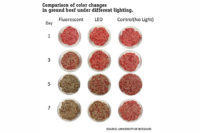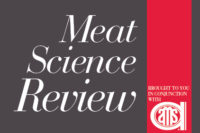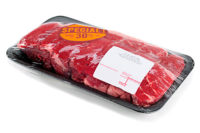The 2010 National Meat Case Study revealed that ground beef accounted for 12 percent of the linear feet in retail meat cases. Not only is it a staple in the American diet, it’s continuously evolving to meet consumer demand — as evident in the variety of formulations and specialty grinds available.
Despite robust marketability, its susceptibility to oxidation and microbial growth results in lost shelf life and revenue. Recent research at Texas Tech University (TTU) has focused on investigating properties and practices which influence the shelf life — and ultimately the profitability — of ground beef under simulated industry and retail conditions.
Temperature is the most variable and impactful component of ground-beef production — with an estimated 50 percent of case life lost at the traditional storage temperature of 2°C. Though it’s understood that cold is better than warm, small variations within cold temperatures can influence case life.
A recent TTU study suggests that storage of chubs at 2.3°C versus -1.7°C accelerated microbial growth and accumulation of discoloration in overwrapped packages after 24 hours of retail display. The effects of the higher temperature were more pronounced as storage progressed through 28 days. This implies that the most common storage temperature (2°C) may not be maximizing ground beef’s shelf-life potential.
As mentioned, the variety of ground-beef products offered in the retail case enhance its marketability. However, it cannot be assumed that shelf life is equal among all formulations. A TTU investigation of the shelf life of 73:27 (lean:fat), 81:19 and 91:9 ground-beef formulations revealed that while initial appearance was influenced primarily by composition, each formulation reacted differently to cold storage and display.
Although it is often assumed that high-fat formulations oxidize and discolor more rapidly, 91:9 ground beef expressed an amount of discoloration equal to or more than that of 73:27 products after 14, 21 and 28 days of cold storage. The inequality in shelf-life among formulations suggests that management parameters specific to a lean:fat formulation may maximize shelf life.
The management of ground beef shelf life often extends to further processing — as evident in the many processors who utilize antioxidant compounds to quell discoloration.
Indeed, the benefits of one of the most common compounds, rosemary extract (RE), are widely known — yet little information about its application method exists. A comparison of direct application of RE to grinds and topical spraying of RE on ground-beef loaves revealed that application method is pivotal: indicating that direct application provides an additional one to two days of acceptable lean color in displayed high-oxygen MAP packages when compared to topically sprayed packages.
The versatility and marketability of ground beef will keep it a retail-case staple. Consequently, development of a more comprehensive understanding of the many variables that influence shelf life must remain an industry priority.




Report Abusive Comment